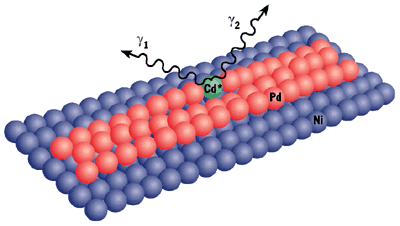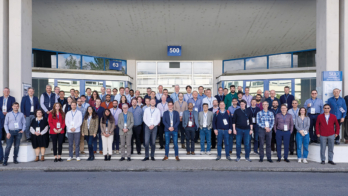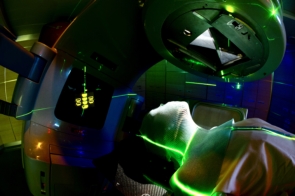Experiments with CERN’s on-line isotope separator (ISOLDE) have led to a novel way to probe the interface between magnetic and non-magnetic ultra-thin layers.
ISOLDE is a source of radioactive-particle beams with applications ranging from nuclear medicine to astrophysics. Recent ISOLDE experiments have opened up a new approach to examining the interface between ultra-thin magnetic and non-magnetic layers. The ultra-high vacuum ASPIC (Apparatus for Surface Physics and Interfaces at CERN) chamber takes keV ions from the 1 GeV proton beam bombardment of an ISOLDE ion source target, evaporates them at eV energies onto carefully cleaned surfaces, and studies interactions at the micro-eV scale. Each experiment covers 15 orders of magnitude in energy to study interactions at an atomic scale. Early results have produced some surprises.

The technique used at ISOLDE is called Perturbed Angular Correlation (PAC) spectroscopy. It relies on probe nuclei with two properties: they must have electric and magnetic moments, and they must decay by emitting two gamma rays nanoseconds apart. This combination of characteristics allows PAC nuclei to spy on neighbouring atoms after being “parachuted” onto surfaces, like secret agents. The interaction of the PAC nucleus’s electric moment with the electric field gradients on and around the surface allows its precise position to be determined. The coupling between the magnetic moment of the PAC nucleus and the magnetic field it feels either applied or due to surrounding nuclei perturbs the correlation between the two gamma rays, allowing information to be gleaned at the atomic scale. This coupling, known as the magnetic hyperfine interaction, gives rise to magnetic hyperfine fields which are often very large.
Surprising result
For example, the magnetic hyperfine field of selenium atoms in bulk nickel is 15 Tesla. The first ISOLDE experiment conducted with the ASPIC chamber was designed to investigate whether this was also true for the selenium atoms deposited as relatively loosely bound atoms, called adatoms, on a surface of ferromagnetic nickel. The result came as a surprise, showing that the field is in fact much lower for selenium as an adatom at around 1 Tesla. This result prompted a theoretical study which revealed a completely different magnetic behaviour for impurities as adatoms compared to impurities in bulk, in agreement with the experiment.
Because hyperfine interactions are of very short range from atom to atom the PAC technique gives resolution to a single atomic layer. Moreover, because the gamma rays have long range, it allows deeply embedded atomic monolayers in a system to be investigated, something which has not before been possible. Furthermore, the technique is extremely sensitive. Only one “spy” atom is needed per thousand atoms on the surface or interface under investigation. Impurities at such a low concentration do not influence the intrinsic properties of magnetic thin layer systems, making PAC atoms the perfect spies.
ASPIC experiments capitalized on these properties by introducing PAC atoms into single atomic layers to investigate the interactions between layers. An isotope of cadmium was incorporated as an impurity into a single layer of palladium on a nickel single crystal. A sample of about 1 square centimetre was used, corresponding to 1015 atoms per layer with 1012 PAC spies incorporated. Results showed that the nickel induces ferromagnetism in the palladium. Further studies showed that this induced magnetism continued through to a second layer, though with much reduced strength. This observation led ISOLDE researchers to ask what would happen deep in palladium if the palladium was covered by ferromagnetic nickel. Seven atomic layers of palladium were deposited on a palladium crystal, after parachuting the PAC probe atoms on to the crystal surface. These were then covered with two atomic layers of nickel. The result was again surprising, showing that in this case paramagnetic palladium was converted into a superparamagnetic material.
Another curious finding is that isolated cadmium probes choose specific sites, called bridge sites, in a palladium monolayer on nickel. This raises the question of whether a larger number of cadmium atoms occupying all bridge sites would break up the structure of the palladium into cells of sub-nanometre scale. If they do, the consequences for the electronics industry could be profound; state-of-the-art today is nanometre-scale devices.
The application of PAC probe atoms to the study of local magnetic properties in ultra-thin layer systems is in its infancy. But these results from ASPIC clearly indicate the power of the technique to provide detailed information about surfaces and interfaces with single-atom precision.





